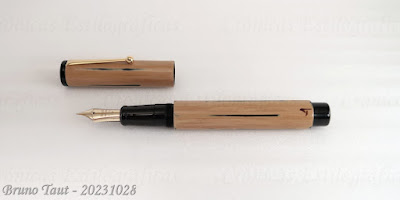We have just seen that the Pilot's model
Custom 74 has been in the market for over 30 years. But what about the direct competitors in the Japanese market?
 The three contenders. From back to front, Platinum 3776 Century, Pilot Custom 74, and Sailor Standard Profit.
The three contenders. From back to front, Platinum 3776 Century, Pilot Custom 74, and Sailor Standard Profit.
Platinum had released the 3776 model in
1978, but this model has gone through a number of modifications over the years, as we had
seen in previous texts. The latest iteration, so far, is the 3776 Century initially released in 2012. At the time, the Century's price was JPY 10000, and it had eight nib options, although the model with the music nib was more expensive at JPY 15000. All of them were made of 14 K gold.
 Platinum 3776 Century Bourgogne, M nib. This color variation does not convey any overprice. JPY 10000 in 2012, JPY 20000 in 2023.
Platinum 3776 Century Bourgogne, M nib. This color variation does not convey any overprice. JPY 10000 in 2012, JPY 20000 in 2023.
Sailor had marketed the Profit model in 1983 based on the 70th anniversary pen of 1981. In 2003-04, the current version saw the market—two cap rings, new nib decoration, etc. By 2012, our reference year, the Standard Profit cost JPY 12000 and offered seven nib options. Should you want a 21 K gold nib in the same size, the price was JPY 15000.
 Sailor Standard Profit, F nib. JPY 12000 in 2012, JPY 13000 in 2023.
Sailor Standard Profit, F nib. JPY 12000 in 2012, JPY 13000 in 2023.
In that same year of 2012, Pilot's Custom 74 with the size 5 nib in 14 K gold had a total of eleven nib options: nine of them for JPY 10000, and two, music (MS) and coarse (C), for JPY 12000.
 Pilot Custom 74 with SM -soft medium- nib. JPY 10000 in 2012; JPY 12000 in 2023.
Pilot Custom 74 with SM -soft medium- nib. JPY 10000 in 2012; JPY 12000 in 2023.
How are these pens in 2023?
The Pilot Custom 74 costs now JPY 2000 more: JPY 12000 for most of the nib points, and JPY 14000 for MS and C nibs.
Platinum has increased the prices a lot more: JPY 20000 for the basic version, and JPY 28000 for the Century with music nib.
Finally, Sailor also increased the prices to JPY 13000, plus an additional hike to JPY 15000 for the zoom and music nibs. (The 21 K option became JPY 22000, and JPY 25000, respectively).
In all three brands, the number of nib options remains untouched, although Pilot did release an new variation—
the S, signature—that is not shown in the catalog.
So, after 10 years, these old pens are still the workhorses of their companies, but the changes in their prices have altered their relative positions with respect to each other.
Pilot is now the cheaper option while having the highest number of nib options.
Platinum's Century is now in a higher price range. This pen is now on par with the Pilot Custom 742 (
size 10 nib), but the Pilot offers many more nib points in that pen—
16.
 Platinum 3776 Century with music nib. It went from JPY 15000 to JPY 28000.
Platinum 3776 Century with music nib. It went from JPY 15000 to JPY 28000.
Sailor's price hike was, proportionally, lower than those by Platinum and Pilot, but still high enough to become more expensive than the Pilot Custom 74. However, Sailor's problem might be different—the immense number of variations in the form of “shop-original pens” creates a complex scenario where the basic Standard Profit became buried if not invisible.
So, the conclusion is that, in this context, the Pilot Custom 74 becomes even more desirable than 10 years ago.
(All prices quoted without taxes. In Japan, VAT is 10%).
Moonman T2 – Pilot Black (Thai version)
Bruno Taut
July 28th 2023
etiquetas: Pilot, Platinum, Sailor, mercado




















































